Delicious recipes for melon blanks for the winter - lick your fingers!
Did you know that melon can be enjoyed not only in summer? Recipes for winter preparations with it amaze with their diversity. We can't wait to share with you and tell you how to make melon jam, ginger melon, candied melon, canned melon in our own juice, and even melon honey!
The content of the article
Which melon is suitable for winter harvesting
The most successful option is a melon of medium ripeness. Overripe will boil over, and unripe will not give aroma and taste. As for sweetness, then for winter recipes it is not important. You can even eat the sweet middle, and use the part that is closer to the crust for the blanks.
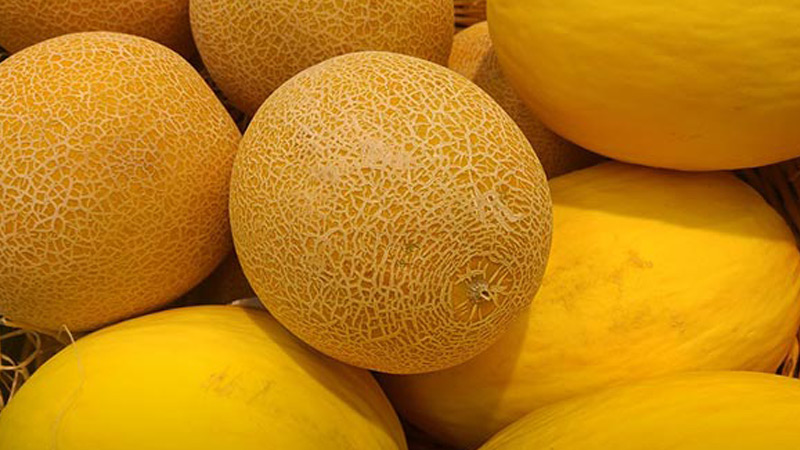
Selection and preparation of fruits
Pay attention to the stalk - it must be juicy and healthy. If it is yellowed and dry, then such a melon is not suitable for winter harvesting. The fruit should not have rotten spots, dry crust.
Preparation includes the following steps:
- Wash the melon, dry with a towel.
- Cut in two.
- Cut out the seeds.
- Cut into large pieces.
- Cut off the crust.
- Cut the pulp into cubes.
Some of the recipes involve blanching, it allows you to keep melon pieces unchanged.
The most delicious melon recipes for the winter
And now for the fun part: 10 best recipes for every taste. The list of ingredients is minimal, most likely they are already in your kitchen. Try a few recipes and make sure that melon cooked for the winter is a lick!
Melon jam
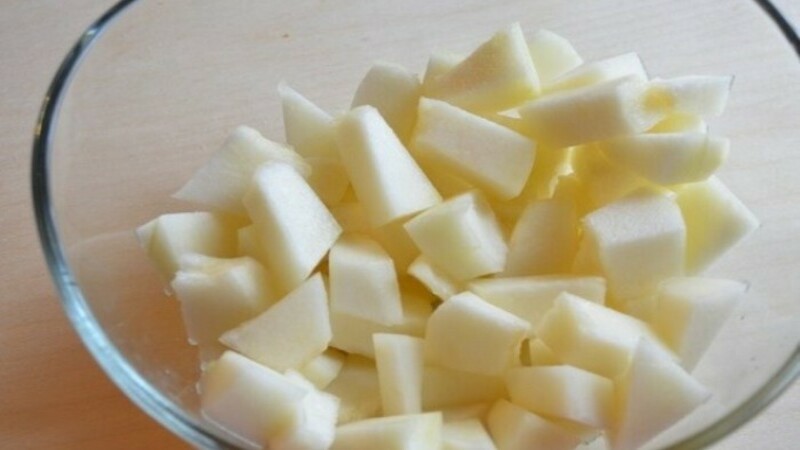
Ingredients:
- 1 kg of melon pulp;
- 1.5 kg of sugar;
- 1 whole lemon
- 1 tsp vanillin.
Cooking method:
- Cut the melon in half, remove the seeds, cut the rind.
- Cut the pulp into large cubes.
- Boil water.
- Dip the melon pulp in boiling water for 5 minutes. This is called blanching.
- Place the pieces in a colander. When the liquid drains, transfer the pulp to the basin.
- Put 1.5 liters of water on the fire.
- Squeeze the juice out of the lemon.
- Add sugar, vanillin and lemon juice to boiling water.
- Boil after boiling for 5 minutes.
- Pour the melon pulp with the syrup and leave for 6 hours. Don't forget to cover with insect gauze.
- After 6 hours, put the bowl with the future jam on the fire.
- After boiling, reduce heat to medium. Cook for 15 minutes, skimming and stirring.
- Remove from heat, cool completely. Best left overnight, covered with a cloth or paper towel.
- Put the cooled jam on clean jars, close. Place immediately in a long-term storage location.
Note. Instead of lemon juice, you can put 0.5 tsp. citric acid.
Melon crust jam
The crust will take longer to cook than the pulp, but the taste will surprise you. To jam turned out soft, take the time and don't skip steps.
Required:
- 1 kg of melon crusts;
- 1.5 kg of sugar;
- 1 tsp citric acid;
- 1 tsp. vanillin.
Cooking method:
- From the crusts, thinly cut the rough outer part, cut into small cubes. If the melon is your own, then the coarse rind can not be cut off.
- Transfer the pieces to a basin. Add sugar. Shake the basin lightly from side to side to distribute the sugar evenly.
- Refrigerate for 2 hours.
- After 2 hours, place the candied crusts on the stove and bring to a boil.
- After boiling, cook for 2 minutes. Cool for 8 hours.
- After 8 hours, bring to a boil again.Foam should form, remove it.
- Cool again for 8 hours.
- Boil the jam a third time, adding citric acid and vanillin.
- Boil for 5 minutes. Turn off the heat, but do not remove from the stove.
- Sterilize clean jars.
- Arrange hot jam in jars and cork.
- Allow the jars to cool for 5-6 hours, then put them away for winter storage.
Council. Since the process of cooking the jam is long, we recommend that you prepare a large amount at once. In this recipe, the ingredients are for 1 kg of crusts.
Candied melon for the winter "lick your fingers"
Ingredients:
- 1 kg of melon;
- 1.5 kg of sugar;
- 125 ml of water for each boil.
Cooking method:
- Rinse the melon, cut in half, remove the seeds.
- Chop the melon into large pieces.
- Cut off the crust.
- Cut the pulp into cubes.
- Put water on fire, add sugar. Boil.
- Throw melon pieces into boiling water, cook for 5 minutes.
- Remove from heat, cool covered for 8 hours.
- Put on fire again. Add water if necessary; no more sugar is needed.
- Cool for 8 hours.
- Boil the future candied fruits again. If the pieces become transparent, then enough is enough. If not yet, then repeat the procedure.
- After the final boil, drain the melon pulp in a colander. This will drain all excess liquid.
- Turn the oven on at 70 ° C.
- Line a baking sheet with baking paper.
- Arrange the melon slices and place them in the oven for 4 hours. Open the door slightly.
Important! The power of the oven is different for everyone, so check the readiness before turning off. Try to click on a piece, if moisture is released from it, then the candied fruits are not ready yet. But it is also not worth overdrying the fruits.
Melon in vanilla syrup
Ingredients:
- Half a small melon;
- 1 tbsp. Sahara;
- 1 tsp vanillin;
- zest of half a lemon.
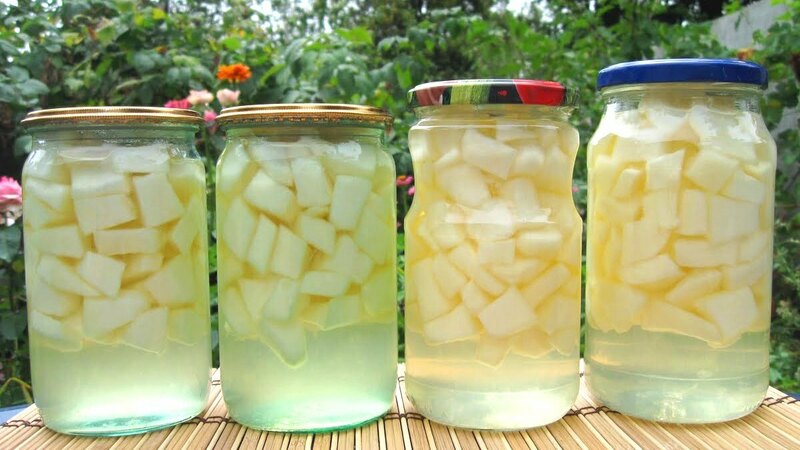
Cooking method:
- Cut the melon pulp into small pieces, remove the seeds and cut the rind.
- Wash and sterilize the jars, pour boiling water over the lids.
- Place the melon pieces in the jar carefully, without crushing them.
- Pour boiling water over the lemon and grate the zest from half on a fine grater.
- Boil water and pour boiling water over melon pieces. Cover with a lid and leave for 10 minutes.
- After 10 minutes, drain the water back into the saucepan, add lemon zest, sugar and vanillin. Boil.
- Boil after boiling for 3-4 minutes.
- Remove from heat and refill cans.
- Using a seaming key, tighten the lids, turn the cans over.
- Remove to storage after two days.
Pickled melon in honey filling
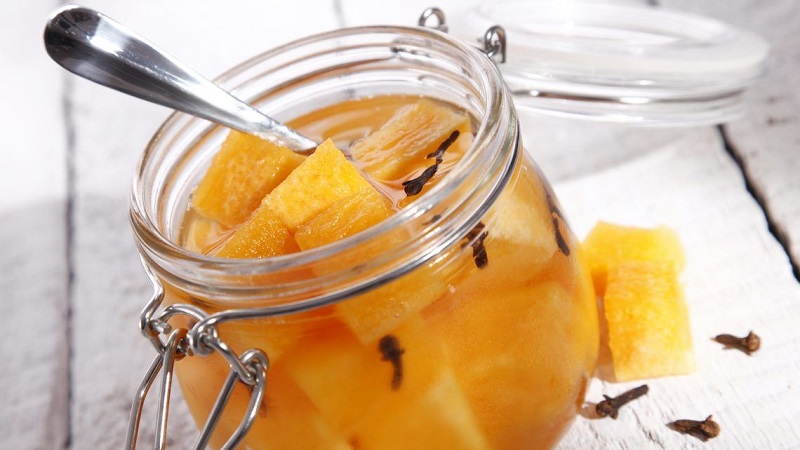
Ingredients:
- 1 kg of melon pulp;
- 1 tbsp. Sahara;
- 3 tbsp. l. honey;
- 0.5 tsp citric acid.
Cooking method:
- Rinse the melon, cut it in half, it is easier to remove the seeds.
- Cut into pieces as you serve.
- Cut off the crusts.
- Cut the pulp into small cubes.
- Sterilize the jars and pour boiling water over the lids.
- Transfer the melon cubes to dry jars.
- Boil water, pour boiling water over the melon.
- Cover with a lid and leave for 7 minutes.
- Boil the same water again, but with the addition of sugar, honey and citric acid.
- After boiling, cook for 3 minutes.
- Remove from heat and immediately fill the container with honey filling.
- Cover with lids.
- Sterilize for 10 minutes.
- Seal with lids.
- Turn the cans upside down and wrap them up.
- After 24 hours, remove to a cellar or other cool and dark place.
Council. Instead of citric acid, you can put pitted lemon slices in the bottom of the container.
Ginger melon
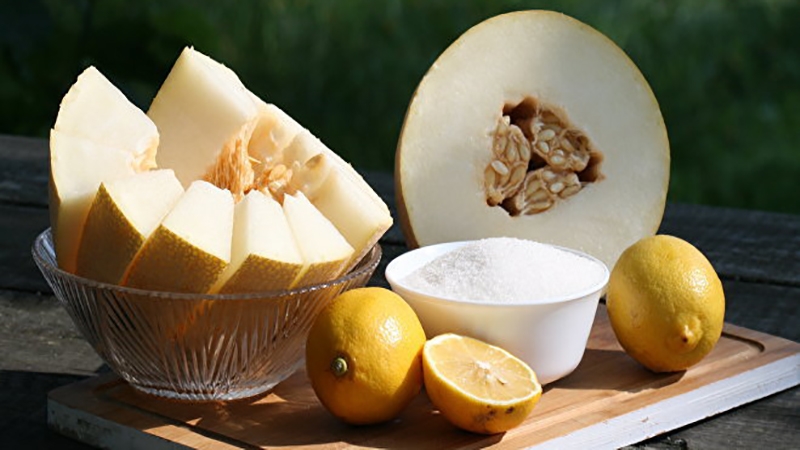
Ingredients:
- 1.5 kg of melon;
- 100 g sugar;
- 1 tsp citric acid or juice of 1 lemon;
- ginger root.
Preservation method:
- Remove the seeds from the melon. Cut off the crust.
- Cut the pulp into pieces or wide short sticks.
- Cut the ginger root into circles.
- Sterilize the banks.
- Boil the lids.
- Place ginger in the bottom of the jar.
- Place the melon slices on top.
- Add sugar.
- Add lemon juice or citric acid.
- Boil water.
- Pour boiling water into jars. Cover with lids.
- Sterilize for 15 minutes.
- Cover and turn over until cooled completely.
Useful information. Ginger root can be grated on a medium grater.
Melon compote with cinnamon and lemon
Ingredients for a 3 liter can:
- 0.5 kg of melon pulp;
- 1 lemon;
- 1 tsp cinnamon;
- 2.5 tbsp. Sahara;
- 2 liters of water.
Cooking method:
- Rinse the jars with soda solution and sterilize.
- Cut the lemon into large wedges (about 6 pieces).
- Remove seeds and rind from the melon.
- Finely chop the pulp.
- Place melon cubes at the bottom of the jar.
- Place lemon wedges on top.
- Add cinnamon.
- Put water on fire.
- Pour sugar into boiling water. Dissolve, mix well.
- Remove the pot from the heat 5 minutes after boiling.
- Pour the syrup gradually into the jar.
- Bury the seaming key.
- Turn the cans over, make sure they are tight.
- Wrap it up.
- After 40 hours, take it to the cellar or closet.
Melon-banana jam
This delicacy will appeal to children, and during the cold season, it will also strengthen the immune system.
Required:
- 800 g melon pulp;
- 2 medium-ripe bananas;
- 1 lemon;
- 600 g of sugar.
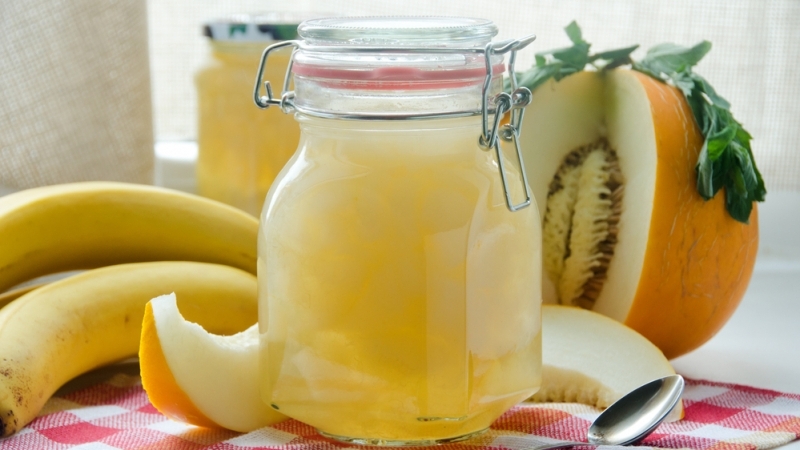
How to cook:
- Remove the seeds from the melon, peel the skin.
- Cut the pulp into pieces of about 2 * 2 cm.
- Transfer the melon wedges to the basin, cover with sugar.
- Pour in a couple of tablespoons of cool water.
- Leave it on for 1.5 hours.
- Cut the lemon in half. Squeeze juice from one directly into a bowl with berries.
- Place the basin over medium heat. Cook, stirring occasionally.
- Finely chop the second part of the lemon along with the zest.
- Peel the banana and cut into round slices.
- Add lemon and banana to the bulk, mix well.
- As soon as the jam begins to resemble a homogeneous mass, reduce heat to low and cook for 40 minutes.
- If foam forms, remove it with a slotted spoon.
- Sterilize the jars. Keep the lids in boiling water.
- Spread out jam by cans and cork.
- Turn it upside down, wrap it up for two days.
- Then put it in a cold storage room or cellar.
Canned melon in its own juice
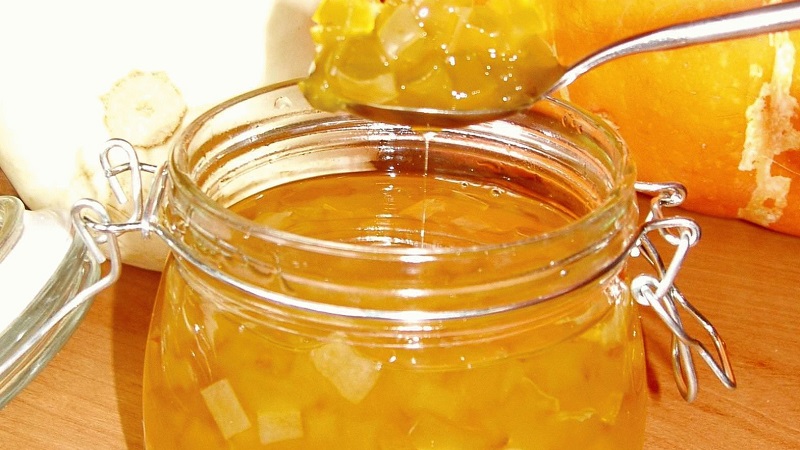
Ingredients:
- 2 kg of melon pulp;
- 1 lemon;
- 250 g sugar;
- 500 ml of water.
Cooking method:
- Prepare two containers, a blender, jars, lids and a seaming wrench.
- Cut the melon in half. Remove seeds, peel off.
- Cut the pulp of one half into large pieces, and the pulp of the other into small pieces.
- Grind small pieces with a blender until smooth.
- Squeeze the juice out of the lemon and add to the resulting puree-like mass.
- Add sugar, mix thoroughly.
- Cook for exactly 25 minutes, keep it off the heat.
- Put water on fire.
- As soon as it boils, dip the second part of the melon wedges into the boiling water.
- Blanch for 5 minutes.
- Prepare a container with very cold water.
- After 5 minutes, remove the pieces from the boiling water and put them in ice water.
- After 3 minutes, transfer the pieces to the bowl of the mixture. It should boil.
- Stir.
- Cook for 15 minutes. Remove the foam.
- Transfer the melon in its own juice to sterilized jars. Cover with a lid.
- Sterilize product for 10 minutes, seal immediately.
- Leave to cool for two days.
Important! There is no need to turn over and wrap up cans of melons in their own juice.
Melon honey
The recipe is simple and doesn't require many ingredients. It turns out the dish is delicious, viscous and sweet, like real honey, children adore it. Spread on white bread, serve with tea.
Ingredients:
- 1 kg of melon;
- 0.5 kg of sugar;
- 80 g of water.
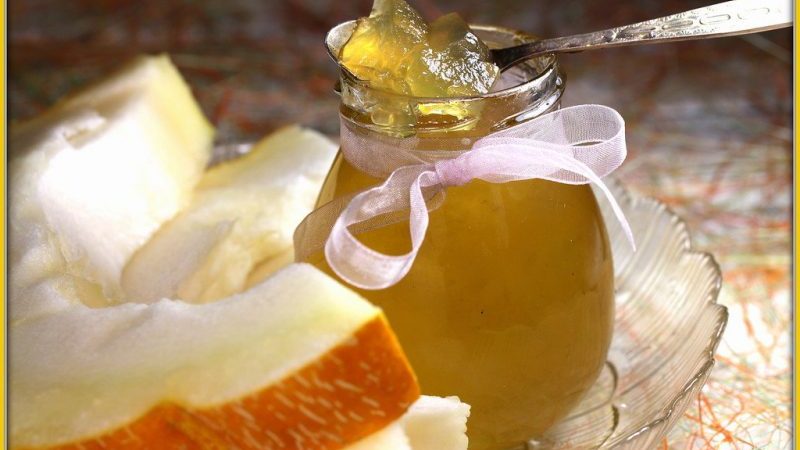
Cooking method:
- Remove the seeds and sweet core from the melon.
- Separate from the crust the part that is closer to the peel. It is most suitable for boiling honey for the winter.
- Cut into small pieces.
- Transfer the melon wedges to a basin, pour in the water and add all the sugar. Stir lightly.
- Put on fire.
- After boiling, cook for 5 minutes.
- Turn off the stove, cool the mixture.
- Boil again for 5 minutes.
- Repeat the algorithm 4 more times.
- While the thick mass cools for the last time, sterilize the jars.
- Put the cooled melon honey in jars and close.
- You can put it away for storage right away.
Note! The number of brews is purely individual! As soon as the melon mixture turns dark and stretches like honey, stop boiling.
Tips and tricks on the topic
Melon preparations for the winter are a novelty for many, so the recommendations of experienced hostesses will not interfere:
- Not only sweet melons are suitable for blanks. If the melon you bought is bland, just add more sugar.
- Jars for any melon harvest should be sterilized.
- Do not add lemon and citric acid at the same time, choose one or the other. Using lemon, you can add juice and zest at the same time.
- If you want to update the recipe, combine melon with watermelon or cherries.
Outcome
You don't have to choose sweet melon for winter harvesting. It is important that she was not overripe and not too green. When cooking with melon pulp, remove the seeds and separate the pulp from the rind.
If you are making jam with crusts, be sure to rinse them off and do not leave a thick layer of pulp. Use lemon or citric acid - they go well with melon and give it a sophisticated taste and aroma.